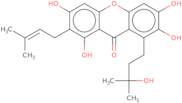Garcinone C
CAS: 76996-27-5
Ref. 3D-FG42698
| 1mg | Descontinuado | ||
| 2mg | Descontinuado | ||
| 5mg | Descontinuado | ||
| 10mg | Descontinuado | ||
| 25mg | Descontinuado |
Informação sobre produto
- 1,3,6,7-Tetrahydroxy-8-(3-hydroxy-3-methylbutyl)-2-(3-methyl-2-buten-1-yl)-9H-xanthen-9-one
- 1,3,6,7-Tetrahydroxy-8-(3-hydroxy-3-methylbutyl)-2-(3-methylbut-2-enyl)xanthen-9-one
- 9H-Xanthen-9-one, 1,3,6,7-tetrahydroxy-8-(3-hydroxy-3-methylbutyl)-2-(3-methyl-2-butenyl)-
- 9H-Xanthen-9-one,1,3,6,7-tetrahydroxy-8-(3-hydroxy-3-methylbutyl)-2-(3-methyl-2-butenyl)- (9CI)
- 9H-Xanthen-9-one, 1,3,6,7-tetrahydroxy-8-(3-hydroxy-3-methylbutyl)-2-(3-methyl-2-buten-1-yl)-
Garcinone C is a natural compound that belongs to the flavonol glycoside family. It has been shown to inhibit protein synthesis in prostate cancer cells and has an inhibitory effect on infectious diseases. Garcinone C also inhibits fatty acid synthesis and the production of prostaglandins. This compound was originally isolated from the roots of Garcinia mangostana L., which is a small tree found in Southeast Asia. The active form of Garcinone C is uridine, which is synthesized from L-ribose and D-glucose by hydrolysis catalyzed by glucuronyl transferase or sugar kinases. Studies have shown that Garcinone C inhibits cycle analysis in carcinoma cell lines, suggesting that it may be useful for cancer treatment or prevention.





